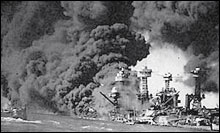Related Links
Encyclopedia: Pearl HarborEncyclopedia: World War IIWorld War II TimelineCasualties in World War IIPearl Harbor: the Movie
Other Content
National Geographic: Pearl HarborEyewitness Accounts of the AttackImperial Japanese Navy PageNational Museum of Naval AviationUSS Arizona Memorial
Although the U.S. military forces in Pearl Harbor had been recently strengthened, the base was not at a state of high alert. Many people were just waking when the first bombs were dropped. No one was prepared to do battle. Japanese aircraft had flown 230 miles from the north, originating from an attack force comprising six aircraft carriers and 423 planes. The assault was the complete surprise the Japanese wanted, even though at 7:02 a.m., almost an hour before the first wave of planes arrived, two Army radar men on Oahu’s northern shore had detected the attack approaching. They contacted a junior officer, who disregarded their reports, assuming they had instead spotted American B-17 bombers expected in from the West Coast of the U.S. The first wave of Japanese planes, made up of 51 Val dive bombers, 50 high level bombers, 43 Zero fighters and 40 Kate torpedo bombers, attacked when flight commander Mitsuo Fuchida gave the now infamous battle cry “Tora! Tora! Tora!” (“Tiger! Tiger! Tiger!”) The second wave arrived shortly thereafter. Almost simultaneously, five Japanese “minisubs” began their attack from underwater, but were able to do little damage. Less than two hours later, 2,280 American servicemen and 68 civilians were dead, 1,109 were wounded, eight battleships were damaged and five sunk. Three light cruisers, three destroyers, and three smaller boats were lost, along with 188 aircraft. The biggest loss that day was the USS Arizona, on which 1,177 crewmen were killed when a 1,760 pound bomb smashed through her decks and ignited her forward ammo magazine causing a terrible explosion. Fewer than nine minutes later she was underwater. Pearl Harbor was the principal but not sole target of the Japanese attack that day. Other military installations on Oahu were hit. Hickam, Wheeler, and Bellows airfields, Ewa Marine Corps Air Station, Kaneohe Bay Naval Air Station, and Schofield Barracks suffered varying degrees of damage, with hundreds of planes destroyed on the ground and hundreds of men killed or wounded. While the attack that day was a huge blow to the U.S. military presence in the Pacific, it was not a total victory for the Japanese. Not only were the attack’s biggest targets, the American aircraft carriers, out of port at the time and therefore saved, but the attack galvanized the nation’s support for involvement in the war, ultimately contributing to the defeat of the Axis powers. Today, more than 70 years later, more than 1.5 million people a year visit the memorial that floats over the sunken Arizona to pay respects to the loss of life that occurred on what President Franklin D. Roosevelt would call “a date which will live in infamy.”
